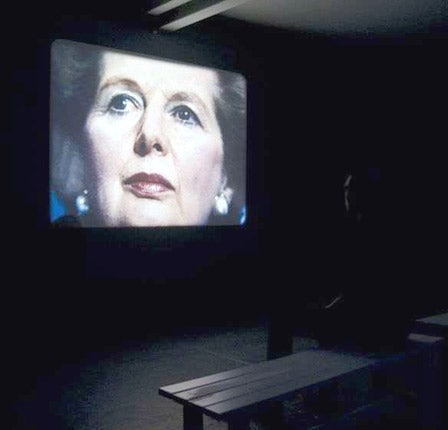Our Magnolia, Nashashibi/Skaer, Doggerfisher, Edinburgh

What do photos of Margaret Thatcher, a washed-up carcass, footage of an American passenger plane and a painting by Paul Nash have in common? They are among the images in Our Magnolia, a 16mm film created by Turner prize-nominated Lucy Skaer and former Beck's Futures winner Rosalind Nashashibi. It's their fifth collaboration and, though both studied at Glasgow School of Art, their first solo show in Scotland, and at a mere four and a half minutes it doesn't demand much of your time. It does, however, test your interpretative skills in its seemingly obscure references and associations.
Our Magnolia is commissioned by doggerfisher, the contemporary art agency and gallery in a converted tyre garage, which also represents Skaer and Nashashibi. The work takes as its starting point the landscape painting Flight of the Magnolia by Paul Nash, an official war artist in both the First and Second World Wars. His single, creamy-pink image of the blossoming shrub, often described as the aristocrat of the plant world, opens the film – its cup-shaped, fleshy flowers seen against a cloud-filled sky. You can almost smell its delicate scent.
Flitting from here to a deserted beach, the film puzzles the viewer with a close-up of a skeletal shape, half buried in the sand. Is it a whale – which would make sense given Skaer's Leonora (Whale Drawing) – or is it, as its beaky head with eyeless sockets suggests, an albatross or similarly gigantic bird around whose decomposed body flies now swarm? A black and white photo of Thatcher is replaced by a vividly coloured version, lips now shiny scarlet, eyes hooded with make-up. The back of a man's head gets irritatingly between us and glimpses of images on a computer screen. A woman cries out in shock – but at what?
The link between visual analogies and the cycle of life and death become clearer when put into the context of the 1944 Nash painting. His subject matter came to him as the threat of an aerial invasion of Britain became a real possibility during the Second World War. "Suddenly the sky was upon us all like a huge hawk hovering, threatening. Everyone was searching the sky expecting some terror to fall." Nash strained his eyes upwards "to see that dreadful miracle of the sky blossoming with these floating flowers". It was the nightmarish picture of these sinister parachute petals which inspired Flight of the Magnolia and others in his "Aerial Flowers" series. Nash later wrote that he could never again be frightened in the same way.
Skaer and Nashashibi have followed his example in assembling and associating different objects in Our Magnolia. The raindrops glinting on magnolia buds are shimmeringly seductive; yet these shots, and others like them, make other, more enigmatic images ominous by contrast. The anguished woman is apparently reacting to the looting of Baghdad's museum during the 2003 invasion while grainy shots of an American plane hint at impending disaster. Our Magnolia may blossom only briefly but its impact resonates. As the Nash original is scored through – observed as though through a fly screen door then seen disintegrating until it disappears – we are left troubled by the sometimes incomprehensible threat of surreal images.
Until 25 September (0131-558 7110; www.doggerfisher.com). Lucy Skaer is featured with her three fellow Turner Prize nominees in a group exhibition at Tate Britain from 6 October until 3 January. Rosalind Nashashibi is featured in a solo exhibition at London's ICA until 1 November
Subscribe to Independent Premium to bookmark this article
Want to bookmark your favourite articles and stories to read or reference later? Start your Independent Premium subscription today.

Join our commenting forum
Join thought-provoking conversations, follow other Independent readers and see their replies